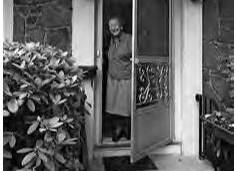
I was delighted recently to attend the one hundredth birthday party of a former patient who I kept in touch with because her wit, charm, and amazing personality made all who knew her want to continue to be in her life. Billie wanted a celebration surrounded by those who were meaningful to her, and the restaurant was packed.
The crowd included her children, grandchildren, great-grandchildren, nieces, nephews, cousins, friends, neighbors, the cleaning woman, the beautician, her aide, merchants from shops she frequented, fellow parishioners, and even the archdeacon of the diocese. Several of her doctors were there, as well as her favorite occupational, physical, and mobility therapists. It was an amazing tribute.
Billie has used this circle of support to help fulfill her dream of aging in place.
Aging in Place
She lives alone in a ranch home in upstate New York. For all intents and purposes she is blind, with only a smidgen of peripheral vision that, with the right light and huge magnification, allows her to enjoy glimpses of her great-grandchildren. With the help of a private aide a few hours a day and the above-mentioned circle of support, she manages to function independently and remain an active, contributing member of her community.
Her family is far away, she has health issues—but she is doing it. Her team runs, for the most part, like a well-oiled machine. She gets rides from the local senior service center to all of her appointments. Friends take her to church and out socializing. A man comes every week to read her mail to her and help pay bills. Her aide comes each afternoon to prepare dinner and helps with weekly chores such as laundry, organizing the fridge, and cleaning up. A volunteer for a local caregiver coalition takes her grocery shopping once a week. The hair appointment is on Thursdays. The cleaning woman comes once a month.
It takes a village.
Assisted Living
Statistics show that the average yearly cost of an assisted living facility ($49,635) or a nursing home ($131,853) makes these options financially prohibitive for many. The viable alternative is to safely age in place. While much depends on the physical and mental health of the individual, the scope of their care team, and available support services, aging in place can be accomplished at a significantly lower cost. The psychosocial benefits of remaining in their own home, continuing to be socially active in their community, and maintaining established relationships are priceless.
My hope is that Age in Place: A Guide to Modifying, Organizing, and Decluttering Mom and Dad’s Home will enable you to create a proactive plan to help your parents thrive in their homes for as long as they desire.
Remember, you are not alone. National statistics reveal that over 10,000 people turn 65 years of age every single day, and that 90 percent of them want to stay in their homes indefinitely. It can be done, and the information in this book will lead you on your journey.
Let us know how you are doing. My Facebook page, the Organized Caregiver, is a place to share progress, frustrations, and suggestions as we learn new ideas and garner support. It’s there as one more way to keep mom and dad safe—and you sane.
 Addendum:
Addendum:
It is amazing how long it takes between handing in a manuscript and completing the final edits and revisions. A year actually.
Today Billie turned 101 and she is still living in her home. Fiercely independent. Aging in place.
©2018 by Lynda G. Shrager. All Rights Reserved.
Reprinted with permission.
Published by Bull Publishing. www.bullpub.com
Article Source
Age in Place: A Guide to Modifying, Organizing and Decluttering Mom and Dad's Home
by Lynda Shrager OTR MSW
 Age in Place: A Guide to Modifying, Organizing, and Decluttering Mom and Dad’s Home is a step-by-step, room-by-room guide to simple and often immediate modifications that can help seniors make their homes safer and easier to navigate. It is designed to help seniors and their caregivers address these new challenges together, to make life at home safer and more manageable.
Age in Place: A Guide to Modifying, Organizing, and Decluttering Mom and Dad’s Home is a step-by-step, room-by-room guide to simple and often immediate modifications that can help seniors make their homes safer and easier to navigate. It is designed to help seniors and their caregivers address these new challenges together, to make life at home safer and more manageable.
Click here for more info and/or to order this book or purchase the Kindle version.
About the Author
 Lynda Shrager, OTR, MSW, CAPS is a registered, national board certified occupational therapist, a master’s level social worker and a Certified Aging in Place Specialist (CAPS) with more than thirty-seven years’ experience in the field of geriatrics and more than thirteen years working with seniors in their homes. In 2009 Lynda became a featured columnist for Everyday Health (everydayhealth.com), one of the country’s leading online consumer health web sites. Lynda combines her expertise as an occupational therapist, master’s level social worker, professional organizer and certified aging in place specialist to pursue her passion of providing therapeutic care in the patient’s home environment and in educating their caregivers. Learn more at otherwisehealthy.com.
Lynda Shrager, OTR, MSW, CAPS is a registered, national board certified occupational therapist, a master’s level social worker and a Certified Aging in Place Specialist (CAPS) with more than thirty-seven years’ experience in the field of geriatrics and more than thirteen years working with seniors in their homes. In 2009 Lynda became a featured columnist for Everyday Health (everydayhealth.com), one of the country’s leading online consumer health web sites. Lynda combines her expertise as an occupational therapist, master’s level social worker, professional organizer and certified aging in place specialist to pursue her passion of providing therapeutic care in the patient’s home environment and in educating their caregivers. Learn more at otherwisehealthy.com.
Related Books
at InnerSelf Market and Amazon

























